
Fresh Water at Sea Page Menu: 1 2 3 4 5 6 7 8 9 Next>>
Fresh Water at Sea in the Golden Age of Piracy, Page 7
Problems with Fresh Water at Sea - Brackish Water
Brackish water, or fresh water mixed with salt water, was sometimes loaded on a ship when they desperately needed water and nothing better could be found. Discussing the expense of water at Mocha, Yemen in 1697, Edward Barlow says the water was brackish, but his comment suggests that they purchased it anyhow.1 William Funnell explained that while at Cape Passeo (near modern day Manta, Peru) in 1704 they took up "a sort of Water, which we call half-wholesome, because it is brackish and tastes as if fresh Water and Salt were mixed together."2
Brackish water was obviously not preferred to fresh. \
An Image of Tortuga (17th Century) Recounting his adventures in 1682, William Dampier noted that "On the South side of it [one of the Roque islands of Venezuela, probably Gran Roque] is a Pond of brackish water, which sometimes Privateers use instead of better"3. While stuck at the Cape Verde Islands due to a combination of weather and illness, George Roberts gratefully acknowledged the efforts of a local who "brought me a cag of sweet Water off [of São Nicolau], which I much longed and wished for; the Water at Bona Vist [Boa Vista, Cape Verde] being brackish, unless a Man brought it down Six or Eight Miles."4
Brackish occasionally had to serve as a short term solution. Among the locations where brackish water was loaded according to the period sailing accounts are Guayaquil, Ecuador5, Chancay, Peru6, Atacama (modern Iquique), Chile7 and Agodonales (modern Tocopilla), Chile8.
The dry season sometimes played a role in causing water to be brackish at a location. Dampier discusses a valley he called Valderas (somewhere near Puerto Vallarta, Mexico) where there "is
\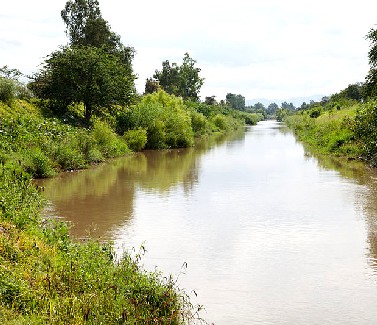
Photo: Leonhard Grünschloss - Rio Ameca
a fine River [the Ameca, near modern Selva El Tuito Park, Mexico], whereinto Boats may enter; but it is brackish at the latter end of the dry Season, which is in February, March, and part of April."9 He similarly explains that when they were at the mouth of the Santiago River near Villa Juarez, Mexico the water was "brackish a great way up"10.
During the wet season, the rivers would flow plentifully and fresh water could be taken up while still at sea near the river's mouth as we have seen. The dry season was another matter. When they were at Tacames (near modern Quingüe), Ecuador, Woodes Rogers' men "met one of the chief Indians painted; and armed with Bows and Arrows: He came friendly; and advised them to go higher up the River, otherwise the Water would be brackish"11.
Sometimes the water was so salty that it couldn't be used. Such was the case for Edward Barlow's crew on the island Fernando de Noronha, Brazil in 167112, Dampier's ship at the Deli River near Belawan, Sumatra in 168813, William Funnell's vessel at Copiapo (near modern Puerto Viejo), Chile in 170414 and Woodes Rogers' fleet at both St. Vincent in the Cape Verde Islands in 170815 and Bahía de Mejillones del Sur, Chile in 170916. When visiting the island of Santiago in the Cape Verde Islands in 1699, Dampier somewhat wryly noted that "'Tis true there is a small Well of brackish Water not half a mile from the Landing-place, which the Asses that carry Salt drink at; but 'tis very bad Water."17
\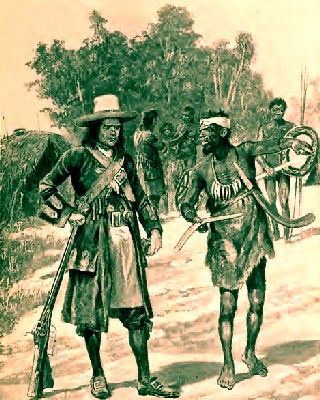
An Imagined Sketch of Dampier in Australis (1906) Even the pirates turned up their noses at brackish water. When James Allison took Jeremiah Tay's ship Good Hope in 1691, they took "everything out of the Sloope, excepting a Little Stincking Brackish water, some Flower, a Little Stincking beefe, and three or foure baggs of wheate"18.
Still, when the situation is desperate, sometimes sailors had to make do. Dampier came up with a clever half solution which allowed him to stretch his fresh water supply. Following a furious hunt for water in the arid northwestern part of Australia (which they called New Ireland) in 1699, Dampier gave the following account:
Next Morning my Men came aboard and brought a Rundlet of brackish Water which they got out of another Well that they dug in a Place a mile off, and about half as far from the Shore [in Australia between Broome and Lagrange]; but this Water was not fit to drink. However we all concluded that it would serve to boil our Oatmeal, for Burgoo, whereby we might save the remains of our other Water for drinking, till we should get more; and accordingly the next day we brought aboard 4 Hogsheads of it19
1 Edward Barlow, Barlow’s Journal of his Life at Sea in King’s Ships, East and West Indiamen & Other Merchantman From 1659 to 1703, p. 468; 9 William Funnell, A Voyage Round the World, 1969, p. 164; 3 William Dampier, A New Voyage Round the World, 1699, p. 55; 4 George Roberts, The four years voyages of Capt. George Roberts, 1726, p. 343; 5 Woodes Rogers, A Cruising Voyage Round the World, 1712, p. 168; 6 Edward Cooke, A Voyage to the South Seas and Around the World, Volume 2, 1712, p. 191; 7 Cooke, Volume 2, p. 232; 8 Rogers, "Appendix", p. 47; 9 William Dampier, A New Voyage, 1699, p. 258; 10 William Dampier, A New Voyage, 1699, p. 268; 11 Rogers, p. 252; 12 Barlow, p. 241; 13 William Dampier, A Supplement of the Voyage Round the World, 1700, p. 157; 14 Funnell, p. 200; 15 Rogers, p. 32; 16 Edward Cooke, A Voyage to the South Seas and Around the World, Volume 1, 1712, p. 175; 17 William Dampier, A New Voyage Round the World, Vol III, Part 1, 1703 p. 29; 18 “53. Declaration of Jeremiah Tay and Others, March, 1691”, Privateering and Piracy in the the Colonial Period - Illustrative Documents, John Franklin Jameson, ed., p. 139; 19 William Dampier, A New Voyage Round the World, Vol III, Part 2, 1703 p. 150
Problems with Fresh Water at Sea - Bad Water
\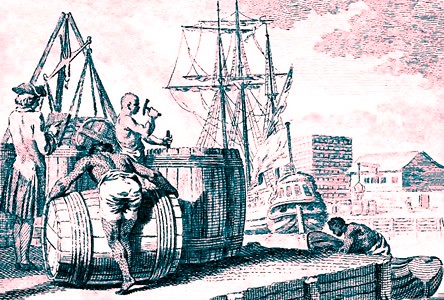
Artists: Joshua Fry and Peter Jefferson
Loading Casks in Port, From a Map of Virginia (1751)
The period accounts contain a variety reports of water going bad while in the cask. Pure water will actually not go bad if it is stored in a clean container.1 Yet, even in the best circumstances, it was unlikely that pure water would be easy to come by for sailors, let alone a clean and/or well sealed container.
Some people thought the best water came from their home port. Yet there were impurities in the usually potable water taken from a home port which could cause problems when left to molder in a cask below decks on a ship. Writing about Dutch East India Company ships historian Jacques De Villiers says, "Drinking water stood in large barrels became turbid and malodorous within a short time, probably as a result of the sulphates present in most surface and well water in Holland."2
When discussing water used by the British Navy on voyages to the East Indies in the 17th century, John Fryer simultaneously boasted about and revealed the problems with water taken from the Thames:
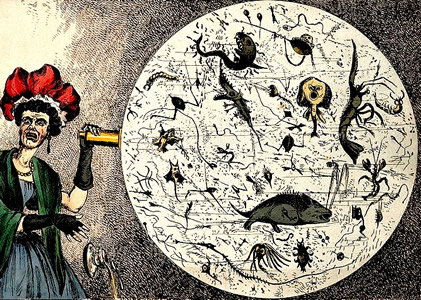
Artist: William Heath
A Dissenting Opinion, "Monster Soup commonly called Thames Water" (1828)
it bears a Body beyond others, and therefore kept till the last to be spent, always reserving a stock thereof to serve them home; for though it stink like Puddle-water when opened first, and have a Scum on it like Oil (which the Coopers affirm they are as cautious to strike with their Adds [Adze] on the Cask for fear of [it] taking fire, as of Brandy itself) yet let it stand unbunged on the Deck twenty four hours, it recovers its goodness, and is the only Water they rely on in an East India Voyage, and therefore they are careful to save it till the last.3
Given all the problems he mentions with the Thames water, Fryer's assertions that it was the best water may seem a trifle bizarre. Historian Andrew Wear suggests that when it came to health, a type of localism was suggested which believed that the environment most suited to a person was that where they were born. Commenting on the death of a sailor from bloody flux (dysentery) near Java, Indonesia in 1672, Edward Barlow noted that it was "a disease that many die of in and about this island, especially [those with] cold country constitutions as English and Dutch; and leaving off their native country victuals and drink, and drinking altogether water and eating the hot country provisions, which are quite countrary to our nature"4.
Slaver captain Thomas Phillips explained that when they got from a little river they found at Principe Island off the West African Coast, "to my taste and apprehension seem’d very good, tho' the distempers and mortality that afterwards happen’d among my men and slaves, made me suspect it did partake of some of the malignity of the island thro' which it runs."5 He doesn't directly explain what this 'malignity of the island' might be, although he adds an interesting detail which may explain the problem. The sailors chose to fill their casks at night, because, during the day, "the women of the town are washing cloaths, and otherwise dirtying and defiling the water all the day time, along the river above the place where we fill"6.
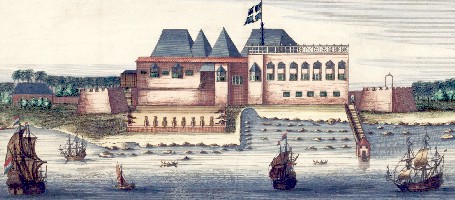
The English Fort in Bombay, India (c. 1665)The healthiness of every location was judged by its environment. Wear explains, "Travellers' impressions of a place visited included health as one of its defining characteristics."7 This is found in some of the sailor's descriptions from the time. For example, when in Bombay, India in 1670, Barlow reported, "The air is not very healthful to our English constitutions being very hot, and the water and air not very good."8 Sailor Alexander Hamilton similarly reported that Bombay had "little good Water on it, and the Air is somewhat unhealthful"9.
The cleanliness of the cask used to contain the water was another matter.
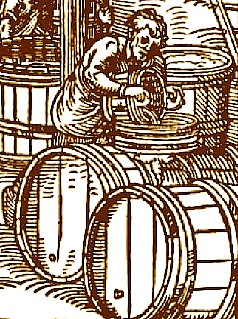
Artist: Jost Amman (1586)
Since casks were hand built, there was potential for both the wood and the worker to impart a number of impurities to the final product. In addition, casks were sometimes reused and may have retained some of their former contents. As mentioned previously, one of the jobs of a ship's cooper was to prepare casks for holding water.10 Woodes Rogers explains that when the stopped at Principe Island off the coast of Africa, "[we] haul’d our empty Casks ashore by Boat-loads, in order to have ‘em burnt and clean’d in the Inside, being Oil Casks; and for want of cleaning, our Water stunk insufferably."11 Rogers mentioned later in the voyage that it was necessary to refill their water casks at Juan Fernandez Island, Chile as a result of "that which we brought from England and St. Vincent São Vicente, Cape Verde] being spoiled by the Badness of the Casks."12 Things may have been better in the Navy, at least at naval outposts. Samuel Pepys, a chief civilian officer of the Navy through most of the late 17th century took steps "to ensure the purity of the source and the quality of the barrels in which the water was stored."13
On ships, water was stored, sometimes in reused casks, typically below decks where it would have been warm and humid when traveling in the West Indies. Here, water "became a reservoir for bacteria and fungi and was foul tasting."14 Sailors didn't always have the luxury of being picky, however. As we have seen, finding any source of potable (or at least seemingly potable) water when traveling by sea could sometimes be the difference between life and death, particularly in less populous and less friendly areas like the West Indies. As a result, ships at sea sometimes had nothing to quench their thirst but bad water.
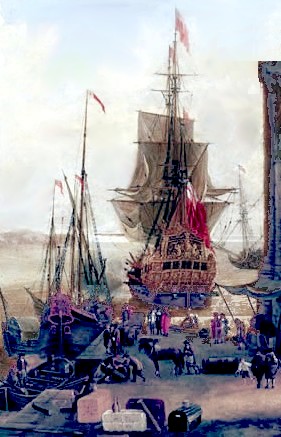
Artist: Jacob Knyff
English and Dutch Ships Taking on Stores
(1673)
Sometimes bad water could be discovered by what was seen in it. Surgeon Johann Dietz noted that while aboard The Hope of Rotterdam on a whaling venture in the late 17th century, "there was against the mainmast a great tub, fixed some distance from the deck, containing water that was often stinking and full of little worms, for the general drinking."15 When captain Alexander Hamilton's men started becoming ill, "I began to suspect that the Water [gathered at Ilha Verde, Macao] might be the Cause, and ordered a large Copper-pot to be filled with it, and to boyl one Half of it away, and set the rest to Cool a day and a Night... on pouring off this water, I found a large Handful of a dark gray salt at the Bottom, of a sharp unsavoury Taste"16. He was later advised by a Portuguese physician that the cause was minerals leeched from the ground by the spring from which water came.
After leaving Bengkulu, Indonesia In 1691, the men on the ship Defiance "began to droop, in a sort of Distemper that stole insensible on them, and proved fatal to above thirty"17. Dampier blamed the water, reporting that "the River-water, wherewith our Ships were watered, was very unwholesome... being nourished by the Water that drained out of the low swampy unwholsome Ground"18. He went on the chastise the sailors, explaining that if they had taken "the trouble they might have fill’d their Vessels with excellent good Water at a Spring on the backside of the Fort [Marlborough], not above 2 or 300 paces from the Landing-Place", even suggesting that it would be wise for the fort to arrange to pipe the water to the shore in the future.19
Things outside of the water were sometimes suggested as a cause of it going bad. Dampier mentions that their water "was stowed among the Pepper in the hold, which made it very hot. Every Morning when we came to take our Allowance, it was so hot that a Man could hardly suffer his Hands in it, or hold a Bottle full of it in his Hands."20 Although he insists this was not because of the temperature in the hold, there was
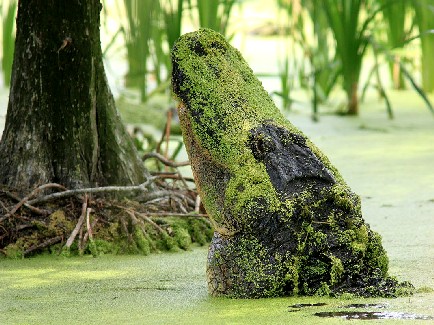
Photo: U.S. Fish and Wildlife Service
The Duckweed May Be Good, But the Crocodile.... At Harris Neck Wildlife Refuge
probably no connection between the warmth of the water and the pepper. However, Dampier also notes that the water "was exceeding black too, and looked more like Ink than Water. Whether it grew so black with standing, was tinged with Pepper, I know not, for this Water was not so black when it was first taken up."21
Perhaps the most interesting inclusion of a foreign agent in ship's water occurred at the advice of a ship's surgeon. William Funnell explains what happened as the men were loading water at Conchagüita, El Salvador. "The water which we took up was very muddy; and on the top of it grew Duck-weed [lemnoideae], as it does usually in our Ditches. At first we raked the Duck-weed away But our Doctor perswading us, that if we took up the weeds, they would mightily preserve our water; we, according to his advice, took up both weeds and water together."22 The surgeon had a point. Even today, duckweed is used as a low-cost way to clean water because it "virtually eliminates pollution by removing nitrogen and phosphates from water."23
1 "Can water go bad?", How Stuff Works Website, gathered 6/15/17; 2 J.C. de Villiers, "The Dutch East India Company, scurvy and the victualling station at the Cape," SAMJ, February 2006, p. 106; 3 John Fryer, A New Account of East India and Persia, 1698, p. 7; 4 Edward Barlow, Barlow’s Journal of his Life at Sea in King’s Ships, East and West Indiamen & Other Merchantman From 1659 to 1703, p. 209; 5,6 Thomas Phillips, 'A Journal of a Voyage Made in the Hannibal', A Collection of Voyages and Travels, Vol. VI, Awnsham Churchill. ed., p.232; 7 Andrew Wear, Knowledge & Practice in English Medicine, 1550-1680, p. 185; 8 Barlow, p. 186; 9 Alexander Hamilton, British sea-captain Alexander Hamilton's A new account of the East Indies, 17th-18th century, 2002, p. 161; 10 Henry Teonge, The Diary of Henry Teonge, Chaplain on Board H.M.’s Ships Assistance, Bristol, and Royal Oak, 1675-1679, 1927, p. 75 & 91; 11 Woodes Rogers, A Cruising Voyage Round the World, 1712, p. 25; 12 Roberts, p. 131; 13 John J. Keevil, Medicine and the Navy 1200-1900: Volume II – 1640-1714, 1958, p. 91; 14 Zachary B. Friedenberg, Medicine Under Sail, 2002, p. 64; 15 Johann Dietz, Master Johann Dietz, Surgeon in the Army of the Great Elector and Barber to the Royal Court, 1923, p. 128; 16 Alexander Hamilton, British sea-captain Alexander Hamilton's A new account of the East Indies, 17th-18th century, 2002, p. 487-8; 17,18 William Dampier, A New Voyage Round the World, 1699, p. 524; 19,20,21 Dampier, p. 525; 22 William Funnell, A Voyage Round the World, 1969, p. 220; 23 Reid Krager, "Duckweed is cleaning up NC's ponds, lagoons", The Charlotte Observer, April 14, 2014, gathered from the internet 6/15/17
Problems with Fresh Water at Sea - Alcohol Instead of Water?
When discussing the problems with water on a ship, it is sometimes suggested that

Artist: Joseph Nicholls - Pirates Drinking & Smoking (1736)
alcoholic spirits were drunk in place of the undesirable, contaminated water. This idea may have grown from the fact that the Navy allowed a gallon of beer a day to their sailors as part of their daily diet.1 Writing before the golden age of piracy, Nathaniel Boteler complained about the Navy's choice not to use iron hoops on the water casks, which he believed caused the beer to spoil. As a result, "we were all of us put to the drinking of stinking infectious water for fourteen days together... it could not but have occasioned so mortal an infection amongst our men as must have endangered both men and ship."2
Yet the beer does not seem to have been much better than the water. In 1653, George Monck, a General at sea in the first Dutch War, "attributed much of the sickness [in the fleet] to beer which was unfit to drink."3 Writing shortly after Monck, Navy Commissioner Nathaniel Bourne said the fleet's beer was "so bad as none can be worse’, and must be thrown overboard."4 Boteler himself admits it was it was "for the most part very undrinkable (whether by bad brewing, or the ill-seasoning of the cask, I cannot say)"5.
Sailor Edward Barlow was even more direct, complaining in 1666 that the 'small' beer (a beer with a low alcohol content) "is as bad as water bewitched, or, as the old saying is amongst us seamen- ‘Take a peck of malt and heave it overboard at London Bridge, and let it wash or swim down the river of Thames as low as Gravesend, and then take it up.’ It would make better beer than we drunk"6.
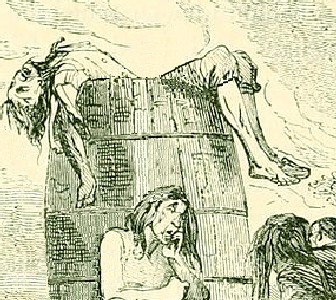
The Bad Barrel, From Master Humphrey's Clock, Vol. 3 (1843)
Perhaps the most graphic account of the foulness of naval beer comes from Admiral Edward Russel, who wrote in July of 1689 that "no longer agoe then yesterday, in several of the but[t]s of beare, great heapes of stuff was found at the bottom of the buts not unlike mens' guts, which has alaramed the seamen to a strange degre"7.
Even if beer had been used in place of bad water, such a plan would probably have been quickly abandoned; historian John Keevil points out "the naval beer of the period had too low an alcoholic content to inhibit bacterial growth."8
Of course, beer wasn't the only alcohol available to sailors - wine, brandy and rum were sometimes provided, although beer was still considered the 'official' drink of the British navy through 1844. However, at a ship's captain's discretion, wine and brandy had long been substituted for beer when it was more cheaply available at foreign ports. Rum was a late-comer to the party, although even it pre-dated the period of interest, probably being given to British navy sailors in place of beer in the West Indies as early as 1655 when the English captured Jamaica.9
Some writers suggest that water was mixed with alcoholic spirits at sea in part to kill off unwanted bacteria in the water.10 This is often presented with reference to grog, which didn't actually become a recognized naval staple until at least a decade after golden age of piracy. (The word 'grog' was given to this drink around 1740, in reference to the man who formally introduced it to the navy - Admiral Vernon, nicknamed 'Old Grogham'.) It is likely that rum was mixed water before this, since it was originally made from molasses by slaves in the West Indies and was probably pretty harsh.
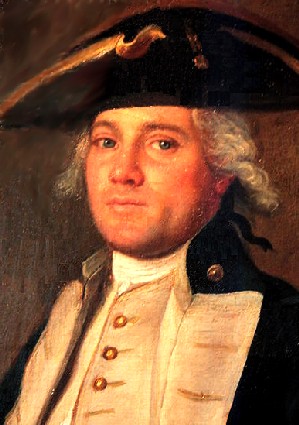
Artist: Francis Hayman - Admiral Edward Vernon (1755)
Even so, the introduction of grog into the naval diet had nothing whatever to do with improving the quality of a sailor's potable water. In fact, it was the other way around.
Admiral Edward Vernon, appalled by ‘that formidable Dagon, drunkenness’, had ordered that, ‘whereas the pernicious custom of the seamen drinking their allowance of rum in drams, and often at once, is attended by many fatal effects to their morals as well as their health, which are visibly impaired thereby… besides the ill consequences arising from stupefying their rational qualities, which make them heedlessly slaves to every passion,’ the daily allowance of half a pint for each man was to be mixed with a quart of water in ‘one scuttled but[t] kept for that purpose and to be done upon the deck’.11
In fact, there is nothing in the period sea literature that suggests mixing alcohol with water would make bad water good. Perhaps the closest we get comes from military surgeon William Clowes, who wrote at the end of the 16th century. Clowes was presented with two sailors with scurvy, who blamed the illness on "their rotten and unwholesome victuals, for they said their bread was musty and mouldy biscuit, their beer sharp and sour like vinegar, their water corrupt and stinking; the best drink they had, they called Beveridge, half wine and half putrefied water mingled together, and yet a very short and small allowance."12
Of course, this doesn't actually say anything about the healthiness of the mixture, only that it was the best of a bad lot. Edward Barlow discusses 'Beveridge' (which he calls 'befraiage") in rather unflattering terms when sailing aboard the 6th rate naval vessel Augustine in 1661:
our beer being almost done, we must now drink "befraiage", which is a drink made of wine and water; and sometimes the wine is as sour as any vinegar, and we must drink that or nothing [alcoholic], and the weather so hot that it causes us to be many times very dry; yet His Majesty allows in his ships "befraiage" wine, that one butt will but make four or five butts of water into "befraiage"; but our purser buys that which will make fourteen to one, having that a great deal cheaper, which is as sour as any vinegar13
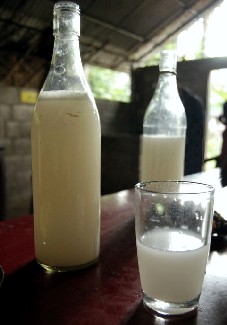
Photo: Dhruvarahjs - Arrack or Palm Wine
The truth is that alcohol did not replace water for most sailors, at best it coexisted with it. Although several examples of contaminated water have been presented here, there are not nearly as many such instances of bad water as there are mentions of stopping to get fresh water during a voyage which is never mentioned as having anything wrong with it. Even the pirates understood the importance of water when they had plenty of alcohol. Richard Lazenby, a prisoner of John (Richard) Taylor's crew reported that after the pirates had spent Christmas 'destroying' most of their provisions the only things they had an abundance of was sugar and arrack (palm wine). Yet, as Lazenby explains, "At this time, they were reduced to one bottle of water per
man, and two pounds of beef, and a small quantity of rice for each a man for ten days, though the water came every day. Had it not been for the arrack and the sugar, most of them must have perished of hunger and thirst."14 Despite the fact that they had so much wine available, they were still rationing out water which shows that the two things necessarily coexisted, even on a pirate ship.
Alcoholic beverages could satiate a man's thirst to some degree, but it is diuretic and not as effective at quenching thirst as water. A diet consisting solely of alcohol would not be healthy for a variety of reasons, particularly in the hot and humid environment of the West Indies. This was understood to some degree by the buccaneers. When buccaneer Captain Townley joined Edward Davis, Charles Swan and François Gronet, William Dampier noted that Townley "distributed his Wine and Brandy, some to every Ship, that it might be drunk out, because he wanted the Jars to carry Water in."15 So while some sailors probably tried to make alcoholic beverages their sole liquid intake, most drank water as well.
1 Karl Vogel, "Medicine at Sea in the Days of Sail," Milestones in Medicine, Edited by James Alexander Miller, New York, 1938, p. 101; 2 Nathaniel Boteler, Boteler's Dialogues, 1929, p. 58; 3,4 John J. Keevil, Medicine and the Navy 1200-1900: Volume II – 1640-1714, 1958, p. 47; 5 Boteler, p. 57; 6 Edward Barlow, Barlow’s Journal of his Life at Sea in King’s Ships, East and West Indiamen & Other Merchantman From 1659 to 1703, p. 127; 7 Keevil, p. 173; 8 Keevil, p. 47; 9 Ed Fox, Post to "Royal Navy Renegades", Pyracy Pub Forum, 2/5/05, gathered 6/16/17; 10 See for example, Rupert Millar, "Top 10 Nautical Drinking Traditions", the drinks business website, gathered 6/16/17, "The History of Grog", Sailor Jerry Website, gathered 6/16/17 and Anna Claybourne, Pirate Secrets Revealed, 2009, p. 16; 11 Kevin Brown, Poxed and Scurvied: The Story of Sickness and Health at Sea, 2011, p. 95; 12 William Clowes, Selected Writings of William Clowes, 1948, p. 119; 13 Barlow, p. 53-4; 14 "56. Richard Lazenby, a prisoner of John Taylor, from The Narrative of Richard Lazenby", Pirates in Their Own Words, 2014, Ed Fox, ed., p. 284; 15 William Dampier, A New Voyage Round the World, 1699, p. 196

